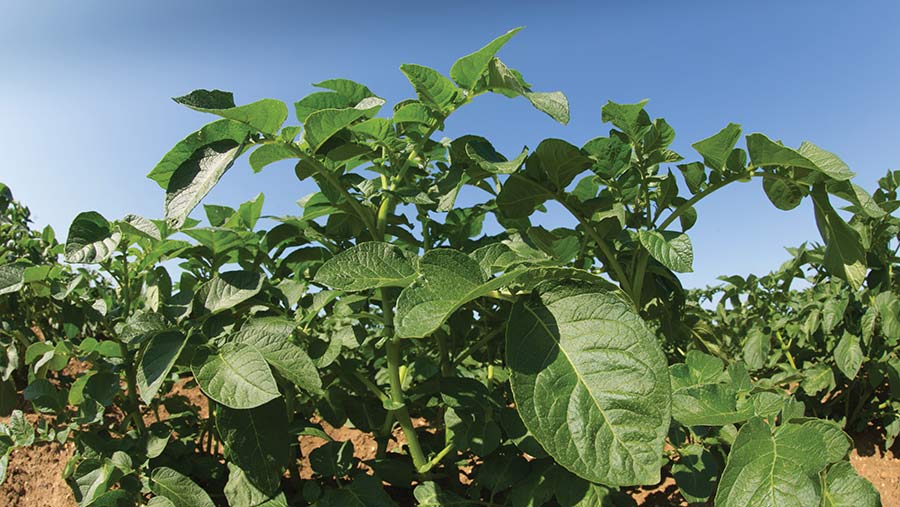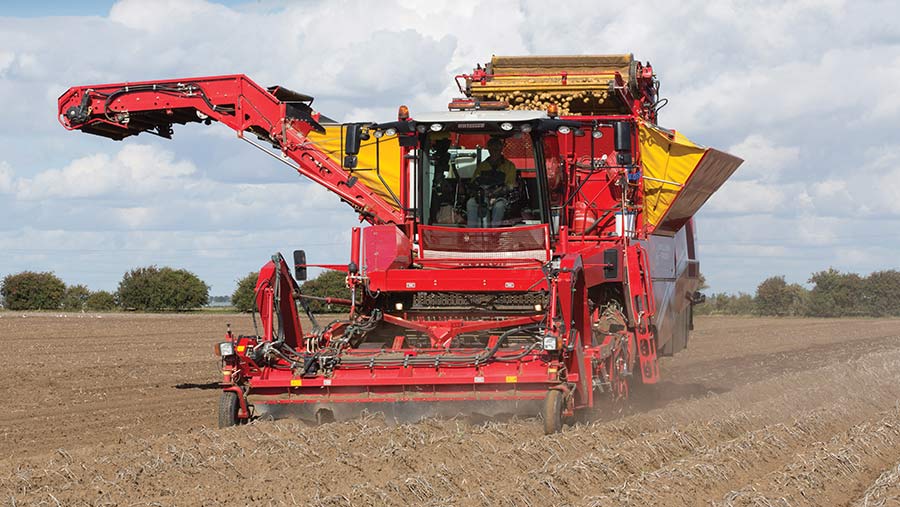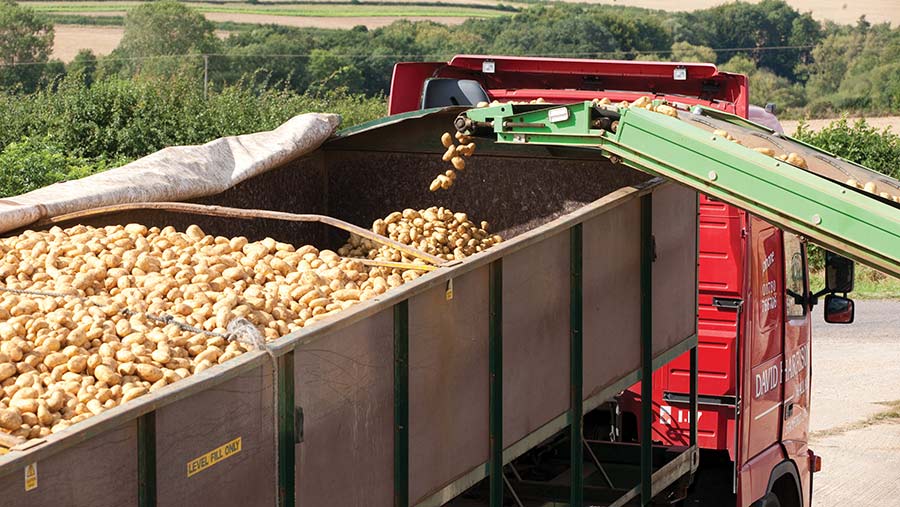How UK potato supplier aims to improve supply chain efficiency
 © Tm Scrivener
© Tm Scrivener The UK’s largest potato supplier is investigating a farm-scale net-zero project which aims to increase efficiency and long-term sustainability across the entire potato supply chain.
Whether it concerns variety choice, cultivations, fertiliser, storage or transport, the three-year project, run by potato supplier Branston, hopes to establish a production method that combats carbon emissions while still producing a commercially viable crop.
Now in its second year, the firm’s field technology manager, Andy Blair, talks us through various field-scale trials that include a novel potato pulp fertiliser, nitrogen-fixing biostimulant and min-till pilots.
These are being carried out by host farmers David Armstrong in Lincolnshire and John Stirling in Scotland.
See also: How regen principles are being applied to potatoes for McCain
1. Novel potato pulp fertiliser
Nitrogen fertiliser is an essential element in growing a crop of potatoes, but it also makes up a significant part of its overall carbon footprint, explains Andy.
“That’s why Branston has developed a novel fertiliser source made from waste potato pulp, which should help release 80% less carbon than standard synthetic fertilisers.”
The novel fertiliser was developed in partnership with clean technology company CCm Technologies, which uses captured carbon dioxide from industrial power generation to stabilise agricultural and industrial waste streams.
Waste potato pulp, a by-product from the peeling process, is heat-treated to a high temperature to avoid disease and bacteria contamination, before being processed into pellet form.
The pellets were applied at a rate of 1.2t/ha to the potato beds at the time of planting, with no further artificial fertiliser used during the season.
“Because the pellet is slow-releasing, a significant rate can be applied at the beginning of the season as most potatoes need nutrition in the early establishment phase.
“At the equivalent rate of nitrogen, the lower-carbon fertilisers show comparable yields to the conventional fertilisers,” says Andy.
The main challenge of pelleted waste fertiliser is that the nutritional value per kilogramme is lower. A higher rate is required, so larger trailed spreaders are often more practical than conventional spinners.
Throughout the project, Branston has been approached by various companies looking for waste products to be used in fertiliser, including waste fire extinguisher contents, which is rich in nitrogen, phosphorus and sulphur.
2. N-fixing foliar feed
A new foliar feed that fixes nitrogen from the air by working as a photosynthetic catalyst was also trialled.
Developed by Crop Intellect, R-Leaf is sprayed directly on crop leaves, and then sunlight turns atmospheric nitrous gases into nitrate that can be used by plants.
The spray was applied at 5 litres/ha, in a little-and-often approach. It is compatible with a range of tank mixes and was used in fungicide treatments for blight control, which can also promote fungicide efficacy.
“Analysis is taking place to assess how much N has been taken up by the plots treated with R-Leaf,” says Andy.
To instantly determine in-field crop requirements, a new system from Canadian company Piketa is providing real-time nutrient analysis by sampling crop leaves.
This has the potential to save the cost of lab analysis and allow growers to respond immediately by feeding the crop what it needs, when it needs it.
Lower nitrogen rates
In both trial fields, a baseline plot with no applied nitrogen was treated with varying levels of nitrogen, from conventional sources.
“From the lowest N rate trials of 0kg/ha to the highest at 160kg/ha there was a 10t/ha yield increase. The biggest difference was the marketability of the potatoes, as the higher nitrogen applications had a greater percentage of bakers,” explains Andy.
3. Reducing cultivations
Low-, medium- and high-level cultivation trials were carried out by host farmers David Armstrong and John Stirling, which essentially reduced five passes to three.
- High-level cultivation Plough, cultivation tine, power ridger with a rotavator blade on the front that tills and then form the ridge, followed by a destoner and then the planter
- Medium-level cultivation Tine cultivator, power ridger, destoner and planter
- Low-level cultivation Ridger working directly into a cover crop, then a destoner and planter

© Tm Scrivener
“Carbon footprinting isn’t just about taking cultivations out, it’s also about fuel use efficiency. It’s no good taking out cultivations if the power ridger is going to work at half the speed and double its fuel consumption,” says Andy.
“This season, we found that cultivation intensity results were dependent on soil type and normal cultivation practices. In some cases a slightly lower cultivation treatment actually gave higher yields and in others it negatively affected yield. We need the right cultivations in the right field rather than a blanket approach.”
The project is also working closely with the University of Lincoln to assess the amount of carbon dioxide and nitrous oxide released through the different cultivation practices.
The University is also researching the impacts of potatoes on mycorrhizal fungi populations and how levels can be promoted.
Varieties
Different varieties may also play a key role in cutting production carbon footprint. New varieties are being assessed to see which ones perform well with low levels of nitrogen and can produce a quality, high-yielding crop with reduced irrigation and lower-quality land.
“We achieved some good results with the variety trials, with new material showing promise at low N levels. Quality and taste panelling of these new varieties is under way. This area of work will be expanded next season,” says Andy.
Transport and storage
As part of the Tuber Net Zero project, Branston plans to optimise crop storage conditions and minimise energy costs.
Working in conjunction with tech firm Crop Systems, a low-energy air-source system known as WarmStor has been introduced to gently warm or cool loads while potatoes are in transit.
Branston is also investigating the efficiency of potato cold stores, using a new system of airflow that does not require a defrost cycle. The firm is assessing the potential for a slightly raised storage temperature while maintaining quality and sprout control.

© Tm Scrivener
An initiative to reduce reliance on wooden boxes during harvest, storage and transport is also under way. Its box-to-bulk transition will enable lorries to transport an extra 4t directly from the field or store to the packing site.
It will remove the need for forklifts to load and unload lorries, as well as avoiding the return of lorry loads of empty wooden boxes to farms.
The potato supplier also uses PerfoTech technology, which analyses the optimum ventilation required for the crop and lasers tiny holes into the film packaging as the potatoes are packed.
The breathable holes can also prevent condensation forming, which helps keep the potatoes fresher for longer, extending the shelf life of potatoes by up to two days for retailers and customers.